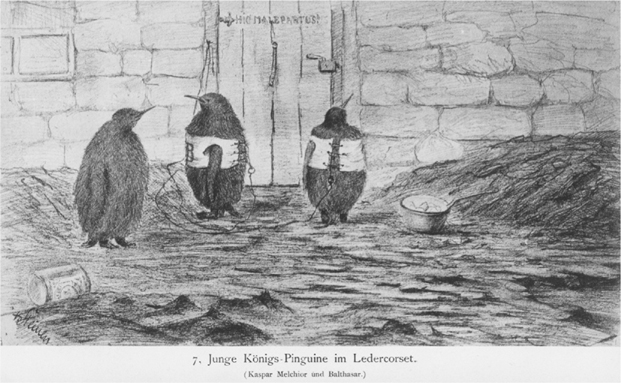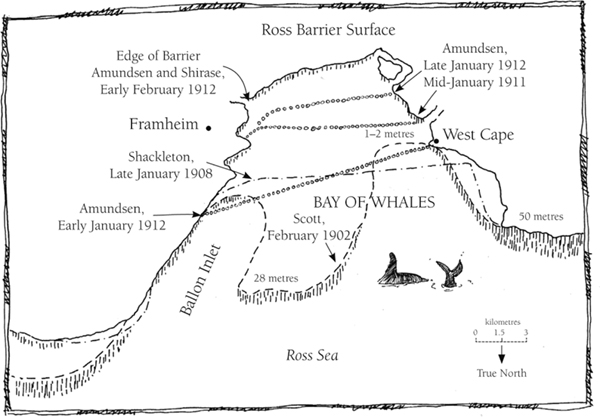1912 (15 page)
Authors: Chris Turney

When Scott had heard that Amundsen was going south, he had reconciled himself to his original timetable. The pole was important, but rushing would jeopardise the broader scientific program. He did not want to race. After all, âit doesn't appear the sort of thing one is out for.' Writing home, in missives reproduced in the world's newspapers, Scott had reflected dryly, âIf he [Amundsen] gets to the Pole he will be bound to do it rapidly with dogs, and one foresees that success will justify him. Anyway he is taking a big risk and if he gets through he will have deserved his luck. Meanwhile you may be sure that we are doing the best we can do to carry out our plans.' In the end, there was not much Scott could do. He was committed to the horses, and the men could not leave until the temperature was high enough for the creatures to cope with the conditions.
Summing up his plans to the expedition members, Scott said, âOne cannot affect to be blind to the situation, the scientific public as well as the more general public will gauge the result of the scientific work of the Expedition largely in accordance with the success or failure of the main object [reaching the South Geographic Pole]. With success all roads will be made easy, all work will receive its proper consideration. With failure even the most brilliant work may be neglected and forgotten, at least for a time.'
Feeling he had done as much as possible, Scott reviewed the expedition's scientific work to date. Weighing it against the likelihood of Amundsen beating him to the pole, he wrote in his diary, âIt is a really satisfactory state of affairs all round. If the Southern journey comes off, nothing, not even priority at the Pole, can prevent the Expedition ranking as one of the most important that ever entered the Polar regions.'
The
Terra Nova
returned to New Zealand with news of what had happened so far. During a meeting of the Royal Geographical Society in April 1911 the president remarked:
One must remember that it is only in civilized lands where the traveller can reasonably expect to escape all misfortunes; whilst, as for true exploration, its course never does run quite smoothly. These misfortunes are to be regretted, but they do not in the slightest degree dim our confident expectations that Captain Scott will produce splendid scientific results, or shake our hopes of his reaching the Pole. As to the Norwegian expedition, it will be best to say but little about it until we have fuller accounts of their proceedings, both past and future. I am glad, however, to take this opportunity of expressing my own personal opinion that no explorer attains any vested rights merely by exploration, and that we should therefore welcome all foreign scientific competition on the Antarctic continent, wherever it may appear, if information
is given in good time in advance. I hope also that cordial relationship will always exist between all Norwegian and British expeditions, as appears in this instance to have been the case. But I cannot refrain from expressing my regret that Captain Amundsen did not give us an opportunity of discussing his Antarctic proposals before he left Europe for the south.

What happened during the following Antarctic summer is one of the great tales of exploration history. Scott has received bad press in recent years, with someâperhaps fairâcriticism of his planning. But his was also a hugely ambitious scientific program. Logistically, the British attempt on the pole was complex, involving sixteen men who peeled off in small groups as the pole was approached, all supported by ten ponies, two dog teams and two motorised sledges.
From the outset Scott was frustrated by slow progress. The weather was ominously changeable: âOne has a horrid feeling that this is a real bad season,' he wrote on 4 December. Large swings in temperature, accompanied by high winds and heavy, wet snowfalls, led to delays.
The motorised sledges found things particularly difficult. Parts were in short supply, and the men struggled to keep the technology going in the alien environment. The sledge chains regularly slipped off and the engines frequently overheated. The convoy would often have to stop and turn them off. Only once the motors had cooled could they be restartedâworryingly, warmed by a blowtorchâand the cavalcade continue. But this intensive nursing was not enough. After several days, with the cylinders cracked and spare parts exhausted, the machines were ignobly dumped and the men were forced to continue on foot, dragging the sledges of supplies and equipment. Scott
must have rued his decision not to bring Skelton, with his intimate knowledge of the motors' inner workings.
The large convoy took fifteen painful days to reach One Ton Depot at 79°29'S. Shackleton, the expedition leader vented in his diary, had been lucky on his expeditionâScott felt it terribly. But his problems were not all down to the conditions. The combination of transport had unintended consequences: the dogs would attack faltering horses and had to be beaten off with sticks. By the time the expedition had reached the base of the Beardmore Glacier the Manchurian ponies had proved a failure. The low temperatures, along with the animals' need for specialised feedstock and their inability to walk on the thin snow crust of the Great Ice Barrier, meant the expedition would often be held up for several days, slowing the British team when they could ill afford it. When the horses did proceed, they often could only drag lighter-than-expected loads.
To make up for lost time, Meares's dogs were ordered to push on. Originally the canine teams were only meant to cross half the barrier. Now they were to carry on to the base of the Beardmore Glacier, something for which they were not provisioned. Supplies were redistributed and Meares's team continued.
At the bottom of the Beardmore, Scott decided to kill the last of the horses and store their meat in a depot. Wary of Shackleton's experiences, he had no intention of having the ponies and their precious cargo fall down a crevasse, threatening the whole expedition. At the base of the glacier, the dogs were also sent backâit would be man-hauling from now on.
Film shot earlier by Ponting indicates how hard this was: men are shown roped to the sledges, connected to a denim harness that spreads the load across the shoulders and stomach. Hauling their loads across the snow, they repeatedly stumble, weighed down with the effort. Cherry summed up the
experience: âPolar exploration is at once the cleanest and most isolated way of having a bad time which has been devised.'
As the expedition pushed on, small teams of men peeled away. Two groups were sent back along the barrier; another at the top of the Beardmore Glacier. One and a half degrees of latitude short of the pole, Scott suddenly announced he would go on with a team of five menânot fourâfor the final assault. Bowers was to join him from the other sledging team and second-in-command Evans was to be sent back with naval personnel Tom Crean and William Lashly. The three men were bitterly disappointedâEvans was furious, convinced Scott had never intended to take him and had appropriated Bowers to make his sledge-pulling easierâbut their return to base proved more than eventful. On the barrier Evans fell down, ill with scurvy. Dumping geological samples to shed weight, Crean and Lashly dragged him on their sledge. Finding they could pull no further, Crean walked, weak from exhaustion, the remaining fifty-six kilometres to Ross Island and returned with help, saving Evans's life.

The pole party's scientific work continued unabated. The surrounding mountains were mapped and geological formations recordedâall precisely fixed by theodolites and compasses. Weather observations were a major focus, and meticulously taken each day. For the sledging teams, however, there would be none of the automatic measurements enjoyed by Simpson back at base. Instead, as
Hints to Travellers
suggests: âOn the march, or whenever good shade cannot be had, it will be found a good plan to attach a string to the top of a pocket thermometer, and whirl the instrument round at arm's length for about half a minute.' Breakfast, lunch and dinner a sling thermometer was religiously brought out, swung vigorously round the body and the temperature noted.
Changes in altitude and atmospheric pressure were monitored by barometer readings. As the men slowly approached the Antarctic Plateau temperatures dropped, routinely hitting -30°C and lower. The tents tested on Cape Crozier proved invaluable.
Fatigue, though, brought about mistakes. As the men approached the pole the two chronometers were found to be off by twenty-six minutes. The difference in time was not merely inconvenient: a precise time-keeping device meant the men could accurately place themselves on the ground. The watches were kept individually in small leather pockets attached to the inner vest and close to the body, shielding the mechanism from extreme conditions to maintain a regular beat. This was critical to fixing the time when the sun hit the highest point in the sky each day, and from this the men's location.
The basic premise is that the sun moves overhead at an average speed of 15° of longitude per hour. By measuring the time when the sun is at its highest point in the sky it is possible to calculate an observer's location relative to the agreed meridian in Greenwich, London. If the time of local noon happened one hour after midday at Greenwich, the longitude would be 15°W. But an error of just a few minutes can lead to a serious miscalculationâso Scott's men brought two chronometers, to cross-check. They were meant to be wound up twice a day, before and after a march.
With the watches now disagreeing, there was a question over location and with it the prospect of the British reaching the pole by the most direct route. Scott was furious, convinced Bowers had not taken care of his device. Bowers recorded in his diary that he âgot an unusual burst of wrath in consequence, in fact my name is mud just at present. It is rather sad to get into the dirt tub with one's leader at this juncture.'
And yet Scott pushed on with increasing confidence. By 6 January the British sledging team was beyond Shackleton's
furthest south. Hopes were highâthey were on the verge of reaching new territory. But, ten days later, a heart-breaking discovery: Bowers spotted a black flag on an upright sledge in the snow. It could mean only one thing.
On 17 January a dispirited Robert Scott and four companions staggered towards their long-sought goal and discovered a solitary small tent flying the Norwegian flag. After seventy-eight days of dragging equipment and food over fourteen hundred kilometres, they had managed to reach the last great unclaimed geographical recordâbut had arrived second.
Amundsen's team had trumped Scott and his men by the slenderest of margins. Wilson wrote in his diary: âall agreed that he [Amundsen] can claim prior right to the Pole itself. He has beaten us in so far as he made a race of it. We have done what we came for all the same and as our programme was made out.'

Captive South Georgian king penguins strapped in corsets by the German polar expedition of 1882â1883. From Karl von den Steinen, in
Die Internationale Polarforschung 1882â83: Die Deutschen Expeditionen und Ihre Ergebnisse
(1891).

